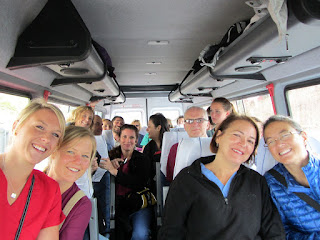 |
| To the clinic! photo by Marie Hasnain |
After breakfast at the hotel our whole group bused back to the Policlinico Belen to start another day of work. Again, my interpreting was needed in the pharmacy. Throughout the morning I dispensed meds and helped to assemble some of the prescriptions. Though we were not as slammed as yesterday afternoon there was still a constant crowd outside the door and each time I gathered in "recetas? recetas?" at least a dozen papers were pushed my way. Those of us working in the pharmacy became quite smooth and effective as a team. Rosa's daughter Claudia helped put together the prescriptions and added an additional translator to the group. We were all working fast. We wrote out basic instructions to give to people along with their meds, though I realized in some situations this wasn't really helpful because the person couldn't read. Like yesterday afternoon, I interacted with countless patients, explaining their prescriptions and clarifying the directions/usage of each medicine we gave them. Again, there was a constant audience around me as I described how each medicine should be taken and as I demonstrated the proper use of inhalers. It seems there was always a circle of curious faces as I leaned in to interact with each patient. There were a significant number of prescriptions for inhalers so I found myself repeating the instructions over and over until the words ran in my head endlessly "quite la tapa, bote todo el aire . . ." At one point, I was demonstrating the use of two different kinds of inhalers to an old woman who spoke only Quechua and did not understand a word of Spanish. A helpful young woman with her baby wrapped in a blanket on her shoulders stepped in to assist as the second translator. Later, when I was translating the specific instructions for three different drugs to an ancient-looking mamita, a bystander who appeared to be her son explained to me that she is blind. So I took her gnarled hand and placed each of the pills in her fingers as I described their proper usage, that she would know how to distinguish between them by feeling. A number of people were impatient, pouncing on me each time I came out the door saying "doctorita, I have been waiting for so long," and pushing against the door. I continually had to ask people to be patient, reminding them that we had dozens of prescriptions inside and that we in the pharmacy team were working as fast as we could. I also noticed that we had a slightly different clientele today than yesterday p.m. Today we seemed to be serving a lot more people who looked like they were slightly better off than those we saw yesterday. While there were still an number of rural people and traditional folk from the communities around Cusco, I did notice a few people who were dressed well, appeared
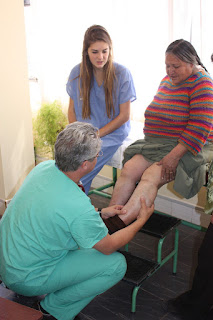 |
| Dr. Paul examining patient, Claudia translating. photo by Alison Nichol |
to have jobs, homes in the city and even cell phones. One or two of the patients we had seen yesterday returned today, including one older woman, Senora Julia, who needed repeat instruction on the inhalers and each of the medicines she had been given. Though we had included written instructions, and though I had explained it all to her yesterday, and though she rewrote what I said again, and though I repeated myself at least three more times again, she still had questions. I understood when she led me by the hand to a bench to sit beside her and explain it all over to her once more that what she really needed was a little attention. She told me that Dr. Paul had recognized an infection in her lungs. I also spent extra time with the mothers whose babies and toddlers required inhalers, showing them how to assemble the spacers and how to correctly administer the medicine to their children. Then I placed it in their hands and asked them to show me how to do it, just to make sure I had been understood.
At lunch (again prepared for us by the nuns) the interpreters and volunteers were given the opportunity to switch positions and try something different. I requested to spend the afternoon translating for my aunt during her patient consultations. I knew that translating between doctor/patient would be more challenging than working in the pharmacy, where the vocabulary and phrases tend to be fairly repetitive. Working with a doctor would require a greater level of vocabulary, adaptability and skill to communicate the needs and
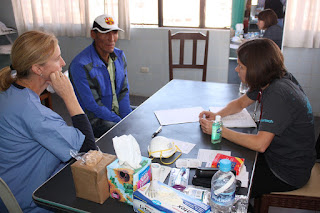 |
| Dr. Elaine consulting patient, Alice interpreting. photo by Alison Nichol |
concerns of the patient and to clearly translate the doctor's response. I was a little apprehensive at first but soon felt more confident and at ease because my aunt Katherine was so clear and concise. I would call each patient into the room by turn, ask them how we could help them and translate everything they said to her. Then with absolute kindness, patience and competence she would tell me what I should translate back to the patient. Sometimes as she was examining an individual she would explain to me aside what she was looking for and why, or she would ask me to touch, feel or examine a certain point of interest so that I could learn. She told me that she touches every patient even if she knows they do not need to be examined because she appreciates how healing simple human touch can be and how important it is for a patient to be given such genuine attention and care.
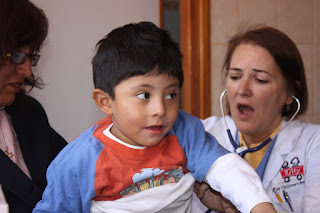 |
| Dr. Rosa with patient. photo by Alison Nichol |
Throughout the rest of the afternoon and until after the sun went down we saw a number of patients. It was an inspiration and an honor to watch my aunt do her work with such skill and compassion. We saw an old mamita accompanied by her daughter-in-law and granddaughter who had been experiencing severe cramping in her hands and feet and aching all over her body. A young woman experienced pain in her joints and severe asthma. A middle-aged man complained of gastritis and problems with his prostate. A woman accompanied by her concerned son showed us a shockingly
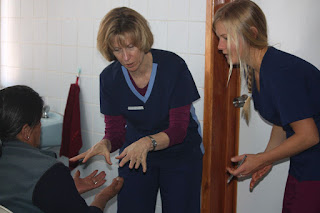 |
| Translating for my aunt, Dr. Katherine Gundling. photo by Alison Nichol |
gnarly scar about the length and width of a pencil where her gallbladder had recently been removed. She began to cry when she told us of the immense pain and suffering she has experienced since the operation. I wondered about the condition of the hospital where she had been treated and could hardly imagine the change in her quality of life due to the constant pain, infection and inflammation in her GI tract. A young woman with an enlarged lymph node was diagnosed with a persistent throat infection. Another patient had severe tendonitis in her knees, which impeded her work (carrying heavy loads to sell at market every day). I was surprised when one patient presented several X-rays and lab results to help in a diagnosis (which ended up just leading to a prescription for multivitamins). An old man in his 80s told us of his chronic constipation that had commenced a year ago and aunt Katherine wondered privately with me about the possibility of colon cancer and the impossibility of the man's situation if this were the case. A 70 year old man who had worked his whole life as a construction worker (and still does) hoped for some alleviation for the aches and pains of his body. For people here, retirement is not even a vague possibility. Another woman presented signs of serious infection in the lungs. So many of the patients we saw complained of chronic aches and pains (no surprise considering how hard people here work) and gastritis---a rather broad and vague term to describe any pain, discomfort, inflammation of the GI tract or indigestion (many complained of constipation).
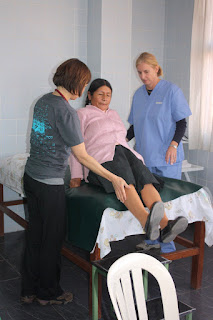 |
| Dr. Elaine and Alice attending to a patient. photo by Alison Nichol |
I interpreted what was said on both sides, found creative was to ask sensitive questions or clarify when something was not fully understood, demonstrated stretching exercises (virtually
every patient complained of chronic musculoskeletal pain) and provided explanations for each prescription. As my aunt wrote each prescription I would tell the patient what she was prescribing for them and gently contend with the endlessness of their needs: "I was also wondering about my gastritis" . . . "and also . . . " . . . "and another question I have . . ." At one point in between patients a woman who had seen my aunt Katherine yesterday burst in the door without warning or invitation to ask a question about one of the medications she had been given. I had thought she was perhaps our next patient, but it turns out she was just waiting for the door to open a crack to push through and get the reassurance she sought. As we were headed out of the clinic after seeing our last patient, a woman stopped me hurriedly to ask about her parents. She was so worried that we would not see them--they had been unable to walk to the clinic due to some light rain showers we had had in the late afternoon. She was visibly relieved when I said we would be returning for another full day of clinic tomorrow.
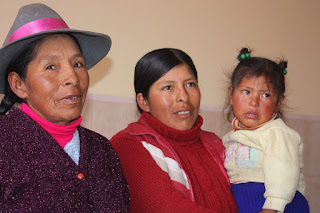 |
| Three generations of patients. photo by Alison Nichol |
I threw a final glance in the pharmacy before leaving the clinic and was surprised at how noticeably our meds and supplies have been decimated by the quantity of patients that came through today. Again, I considered the challenge for our doctors to work within such limitations of time and resources, and to deal with the very critical issues presented by some of the patients within the space of one single, relatively short visit. The needs of the people here are intense and seemingly endless. As we waited in the dark for the bus to take us back to our hotel a couple of us struck up a conversation with an old couple standing in the doorway of their small shop across the street from the clinic. We complimented the old mamita on her white tophat. A cute scruffly dog sat at her feet. She was wondering if we could help her with her arthritis and when I invited her to come to the clinic tomorrow, she told me she would prepare a special Peruvian snack for us and bring it in the morning.
Though night had fallen the streets of Cusco were full of people and busy activity as we rode back to the hotel. As our driver deftly maneuvered through the press of taxis and the daring dash of vehicles through traffic and diesel smoke, Rosa recounted the story of a 91 year old patient who had arrived at the clinic earlier to see Dr. Paul, the pulmonary specialist. She had arrived carried over the shoulder of her grandson like a cherished sack of potatoes. She came with blue skin because she was getting such little oxygen. Paul and Rosa immediately realized that she was in too critical condition for the capacities of our clinic and sent her to the hospital emergency room. Her grandson lifted her over his shoulder again and they took off in a taxi. Rosa said it is unlikely the woman is still alive. We returned to the hotel subdued, reflective and exhausted.
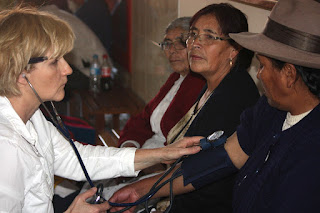 |
| Clydene screening patients. photo by Alison Nichol |